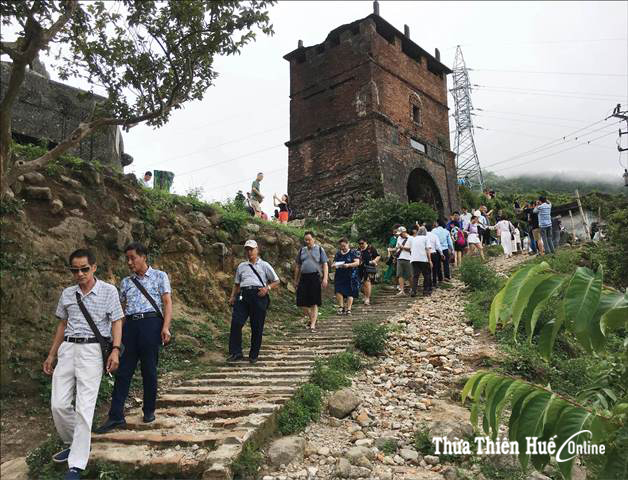
Hai Van Gate is overcrowded with tourists.
I remember just 2 years ago, on the way to Hue from Da Nang, my friend and I decided to take the road through the pass so as to visit Hai Van Gate. In about one hour, we noticed except us, just a few tourists dropped by now and then to find out what the obsolete architectural complex on top of the mountain was.
At that time, I felt so regretted about Hai Van Gate when I compared it with the ancient fortress and the war-torn church at Malacca Strait in Malaysia, always overcrowded with tourists. I dreamt of the day when this monument would become a highlight on the heritage route in Central Vietnam. And now, after two years, as never before, my dream about that beautiful highlight seems very close to becoming true.
Hai Van Gate now is no longer desolate, but bustling with tourists, not only domestic, but also foreign from Korea, China, Britain, Germany, France, Japan, etc. The fact that the parking area on top is filled with 30/45-seat-coaches shows that tourists as a group have outnumbered individual tourists. Tourists as a group certainly have a guide who provides them with more detailed information about Hai Van Gate. Hai Van Gate thus, together with the world’s leading spectacular pass, will be more widely known.
Hai Van Gate is regarded as the gateway to Hue Citadel to the south, located on top of Hai Van Pass at an altitude of nearly 500m above sea level. The gateway had been there from ancient times, but it was not until the 7th year of Minh Mang’s reign (1826) that the gate was built with protective walls, cannons, solid and large-scale warehouses to make the gate compatible with such an essential function.
On the door to the south, there is a stone tablet on which inscribed the three big-sized Chinese characters “Hai Van Gate”; on the back door to the north, the six words “Thien Ha De Nhat Hung Quan” (“The Most Grandiose Gateway of All”) and the date (built on a good day in the 7th year of Ming Mang’s reign.) The title is told to be said by King Le Thanh Tong when he stopped on the summit of Hai Van Pass and got inspired more than 500 years ago.
Later on, the National Road 1A was straightened and no longer runs through Hai Van Gate. However, both the French and the American recognized the importance of this peak. They therefore set up there a solid system of bunkers and connected trenches to occupy the space and control the life-line traffic through Central Vietnam. Many fierce battles took place here whose vestiges can still be seen now.

Many large-sized coaches bring tourists to Hai Van Gate
Lying in the midst of majestic mountains and forests; winds and clouds, such an interesting destination had been for a long time ignored with no management and at the risk of becoming ruins. Fortunately, after the "handshake on top of Hai Van Pass" between Thua Thien-Hue and Da Nang, everything began to change. The first meaningful milestone was its recognition as a National Monument, which becomes important jurisdiction for Thua Thien-Hue and Da Nang to work together to manage, protect and promote the value of the relic.
It was as if Hai Van Gate had just been woken up after a long sleep. There are still many things ahead waiting to be done such as embellishing the monument, enhancing the landscape, providing appropriate services, etc., so that Hai Van Gate, the highlight on “the road in clouds” and “the world’s leading spectacular pass of the world” will be certainly an interesting stop that no tourists can miss on their travel throughout Vietnam.
Story and photos: Hien An